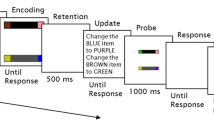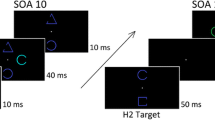Summary
Different properties of the visual array are encoded in the brain in a variety of different, specialized subsystems. Some of these subsystems are spatiotopically organized; others appear not to be. The question arises as to how information regarding different properties of the same visual object, encoded in different spatiotopic and non-spatiotopic subsystems, is co-ordinated or integrated in the selective control of action. In our experiments, subjects are instructed to name selectively just one object among a briefly presented, and pattern-masked, array of other objects; the object to be named is specified either in terms of its colour and/or in terms of its relative location in the array. We also manipulate the categorical relation between the target object and its surrounding non-targets. Our results indicate that, even at quite short exposures (short masking SOA), categorical identity information is available, but that this information has not yet been co-ordinated with information about relative position or colour. Integration of identity and relative position information begins to appear in the selective control of action only at relatively long masking SOAs and continues over several hundred milliseconds. Even when the target is the only member of the designated response-set in the display, other items surrounding the target interfere with target selection. Outer items in a spatial cluster of items may be segmented earlier than central items, and the integration of identity and position information appears earlier for ‘outer’ positions. We put forward a preliminary outline model of visual attribute integration in the selective control of action and in the creation of episodic memory.
Similar content being viewed by others
References
Allport, D. A. (1977). On knowing the meaning of words we are unable to report: the effects of visual masking. In S. Dornic (Ed.), Attention and performance: Vol. 6. Hillsdale, NJ: Erlbaum.
Allport, D. A. (1979). Conscious and unconscious cognition: A computational metaphor for the mechanism of attention and integration. In L. G. Nilsson (Ed.), Perspectives on memory research. Hillsdale, NJ: Erlbaum.
Allport, D. A., Tipper, S. P., & Chmiel, N. R. J. (1985). Perceptual integration and post-categorical filtering. In M. I. Posner & O. S. M. Marin (Eds.), Attention and performance: Vol. 11. Hillsdale, NJ: Erlbaum.
Bachmann, R. (1984). The process of perceptual retouch: nonspecific afferent activation dynamics in explaining visual masking. Perception & Psychophysics, 35, 69–84.
Bjork, E. L., & Murray, J. T. (1977). On the nature of input channels in visual processing. Psychological Review, 84, 472–484.
Bundesen, C., Pedersen, L. F., & Larsen, A. (1984). Measuring efficiency of selection from briefly exposed visual displays: A model for partial report Journal of Experimental Psychology: Human Perception and Performance, 10, 329–339.
Butler, B. E. (1975). Selective attention and target search with brief visual displays. Quarterly Journal of Experimental Psychology, 27, 467–477.
Butler, B. E. (1980). Selective attention and stimulus localization in visual perception Canadian Journal of Psychology, 34, 119–133.
Butler, B. E., & Currie, A. M. (1986). Attention in the periphery: a new look at lateral masking Psychological Research, 48, 201–209.
Cheeseman, J., & Merikle, P. M. (1986). Word recognition and consciousness. In D. Besner, T. G. Waller, & G. E. MacKinnon (Eds.), Reading research: Advances in theory and practice: Vol. 5. New York: Academic Press.
Coltheart, M. (1980). Iconic memory and visible persistence. Perception & Psychophysics, 27, 183–228.
Crick, F. (1984). Function of the thalamic reticular complex: The searchlight hypothesis. Proceedings of the National Academy of Sciences, 81, 4586–4590.
Eriksen, C. W., & Rohrbaugh, J. W. (1970). Some factors determining efficiency of selective attention American Journal of Psychology, 83, 330–343.
Essen, D. C. van & Maunsell, J. H. R. (1983). Hierarchical organization and functional streams in the visual cortex. Trends in Neurosciences, 6, 370–375.
Gaffan, D., & Saunders, R. C. (1985). Running recognition of configural stimuli by fornix-transected monkeys. Quarterly Journal of Experimental Psychology, 37B, 61–71.
Graves, R. S. (1976). Are more items identified than can be reported? Journal of Experimental Psychology: Human Learning and Memory, 2, 208–214.
Gross, C. G., Desimone, R., Albright, T. D., & Schwartz, E. L. (1983). Inferior temporal cortex and pattern recognition. In C. Chagas, R. Gatass, & C. Gross (Eds.), Pattern recognition mechanisms: Vol. 54. Rome: Pontificae Academiae Scientiarum Scripta Varia.
Johnston, W. A., & Dark, V. J. (1986). Selective attention. Annual Review of Psychology, 37, 43–75.
Kahneman, D., & Treisman, A. M. (1984). Changing views of attention and automaticity. In R. Parasuraman & R. Davies (Eds), Varieties of attention. New York: Academic Press.
Kohonen, T., Oja E., & Lehtio, P. (1981). Storage and processing of information in distributed associative memory systems. In G. E. Hinton & J. A. Anderson (Eds.), Parallel models of associative memory. Hillsdale NJ: Erlbaum.
Levine, D. N., Warach, J., & Farah, M. (1985). Two visual systems in mental imagery: Dissociation of ‘what’ and ‘where’ in imagery disorders due to bilateral posterior cerebral lesions. Neurology, 35, 1010–1018.
Logan, G. (1975). On the independence of naming and locating masked targets in visual search. Canadian Journal of Psychology, 29, 51–58.
Marcel, A. J. (1983). Conscious and unconscious perception: An approach to the relation between phenomenal experience and perceptual processes. Cognitive Psychology, 15, 238–300.
Merikle, P. M., Coltheart, M., & Lowe, D. G. (1971). On the selective effects of a patterned masking stimulus. Canadian Journal of Psychology, 25, 264–279.
Mewhort, D. J. K., Campbell, A. J., Marchetti, F. M., & Campbell, J. I. D. (1981). Identification, localisation and “iconic memory”: an evaluation of the bar-probe task. Memory & Cognition, 9, 50–67.
Murray, E. A., & Mishkin, M. (1985). Amygdalectomy impairs crossmodal association in monkeys. Science, 228, 604–606.
Nissen, M. J. (1985). Accessing features and objects: is location special? In M. I. Posner & O. S. M. Marin (Eds.), Attention and performance: Vol 11. Hillsdale, NJ: Erlbaum.
Rolls, E. T. (1986). Information representation, processing and storage in the brain: analysis at the single neuron level. J. P. Changeux & M. Konishi (Eds.), Neural and molecular mechanism of learning. Berlin: Springer-Verlag.
Sperling, G. (1960). The information available in brief presentations. Psychological Monograph, 74 (11).
Stone, J., & Dreher, B. (1982). Parallel processing of information in the visual pathways: a general principle of sensory coding? Trends in Neurosciences, 5, 441–446.
Ungerleider, L. G. (1983). The corticocortical pathways for object recognition and spatial perception. In C. Changes, R. Gattass, & C. Gross (Eds.), Pattern recognition mechanisms: Vol. 54. Rome: Pontificae Academiae Scientiarum Scripta Varia.
Ungerleider, L. G., & Mishkin, M. (1982). Two cortical visual systems. In D. J. Ingle, M. A. Goodale, & R. J. W. Mansfield (Eds.), Analysis of visual behaviour. Cambridge MA: MIT Press.
Author information
Authors and Affiliations
Additional information
Paper contributed to Symposium on Visual Attention and Action at the Centre for Interdisciplinary Research (ZIF), University of Bielefeld, Federal Republic of Germany, July 1985
Rights and permissions
About this article
Cite this article
Styles, E.A., Allport, D.A. Perceptual integration of identity, location and colour. Psychol. Res 48, 189–200 (1986). https://doi.org/10.1007/BF00309083
Issue Date:
DOI: https://doi.org/10.1007/BF00309083




